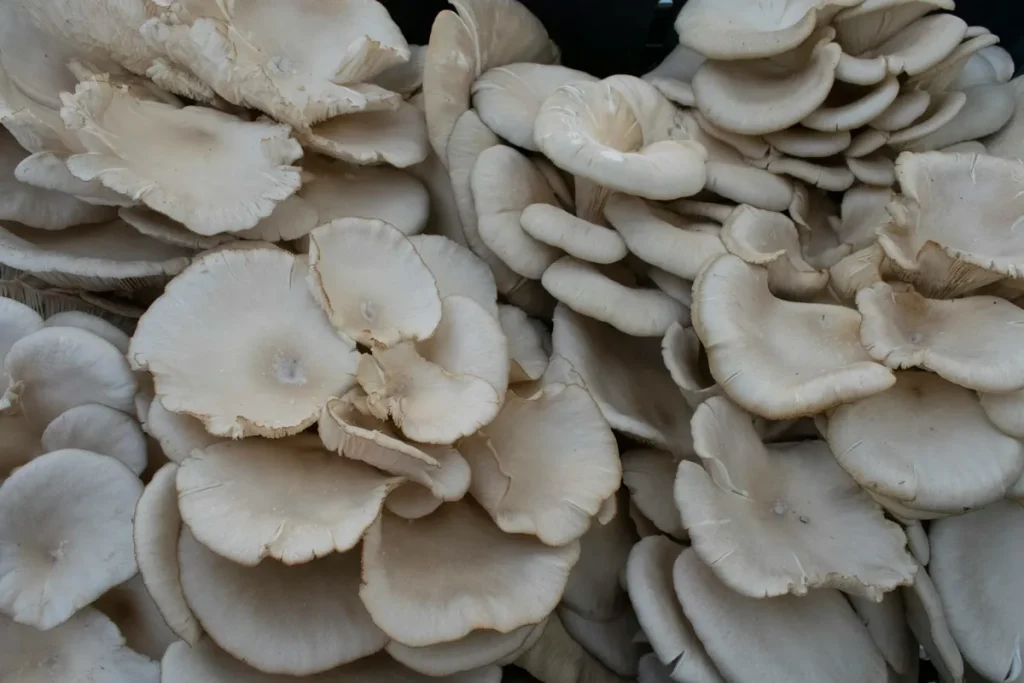
Grow oyster mushrooms using grass substrates to create a sustainable, profitable, and low-cost mushroom farming system. Oyster mushrooms (Pleurotus spp.) are widely appreciated for their savory flavor and high nutritional value. Traditionally grown on sawdust or rice straw, they can now be cultivated on grass—a resource that’s more accessible and equally effective.
This complete guide shows you how to grow oyster mushrooms using grass substrates such as flute reed (Phragmites karka), wild cane (Saccharum spontaneum), and tiger grass (Thysanolaena latifolia)—all commonly found in Southeast Asia.
Why Grow Oyster Mushrooms Using Grass Substrates?
Choosing to grow oyster mushrooms using grass substrates provides several benefits:
- Locally available materials: Wild grasses are abundant and free.
- Eco-friendly: Reduces the need for wood products.
- Low-cost: No need for commercial sawdust or synthetic inputs.
- Repurposes biomass: Transforms agricultural waste into valuable produce.
Step 1: Preparing Grass to Grow Oyster Mushrooms Using Grass Substrates
- Harvest the Grass: Cut mature grasses and let them dry under the sun until crisp.
- Chop into Pieces: Use a shredder to reduce grass length to 3–5 cm.
- Add Nutrients and Water:
- For every 100 kg dried grass, add:
- 1 kg urea
- 0.5 kg slaked lime
- Adequate water for even moistening
- For every 100 kg dried grass, add:
- Compost the Grass:
- Form into a heap and cover with plastic (leave top open for airflow)
- Turn every 3 days for proper fermentation
- On the second turning, add 200 grams magnesium sulfate (MgSO4.7H2O)
- Compost is ready in 10 days
Step 2: Moisture Check and Nutrient Boost When You Grow Oyster Mushrooms Using Grass Substrates
Squeeze a handful of compost: it should feel moist with only a few drops of water. This ensures the substrate has the ideal 65–70% moisture content.
To enrich the substrate, mix in 6 kg rice bran per 100 kg of compost. This addition improves the substrate’s nutrient profile.
Step 3: Bagging the Substrate to Grow Oyster Mushrooms Using Grass Substrates
- Filling Bags:
- Use 18×35 cm polypropylene grow bags
- Fill with 1 kg of the prepared substrate
- Press down tightly to remove air gaps
- Sealing:
- Place a plastic ring around the opening
- Plug the mouth with clean cotton for air exchange
Step 4: Pasteurizing the Bags for Safe Growth
- Steam the filled bags at 100°C for 3 hours
- Allow to cool to room temperature before inoculation
Step 5: Inoculating Spawn to Grow Oyster Mushrooms Using Grass Substrates
- Use quality grain spawn of Pleurotus spp.
- In a clean workspace, add spawn into each bag
- Gently shake to distribute evenly
Step 6: Incubation Process for Growing Oyster Mushrooms
- Keep bags in a dark, ventilated room
- Maintain temperature at 24–28°C
- After 12–15 days, the substrate should be fully colonized by white mycelium
Step 7: Fruiting and Maintenance to Grow Oyster Mushrooms Using Grass Substrates
- Initiate Fruiting:
- Remove cotton plugs
- Place bags on shelves in a shaded, humid area
- Set Conditions:
- Humidity: ≥85%
- Spray water at least twice daily
- Provide soft light (8–12 hours)
- Harvesting:
- Mushrooms appear within 3–5 days after fruiting starts
- Harvest when caps are mature but not fully flattened
Step 8: Achieving Multiple Harvests When You Grow Oyster Mushrooms Using Grass Substrates
- Bags can produce 3–5 flushes in 2–3 months
- Rest bags between flushes
- Avoid overwatering to reduce contamination risk
Step 9: Reusing Materials After You Grow Oyster Mushrooms Using Grass Substrates
- After final harvest, empty bags
- Use spent substrate as fertilizer
- Sanitize your grow area before the next batch
Tips to Successfully Grow Oyster Mushrooms Using Grass Substrates
- Mix in 2–3% biochar for better aeration
- Maintain good air exchange to avoid CO2 buildup
- Choose grass types based on local availability
- Reuse grow bags and accessories to save resources
Final Thoughts on How to Grow Oyster Mushrooms Using Grass Substrates
Grow oyster mushrooms using grass substrates to tap into a cost-efficient, sustainable method suitable for both beginners and experienced farmers. With the right materials and techniques, you can turn common grasses into a high-value food product and income stream.

